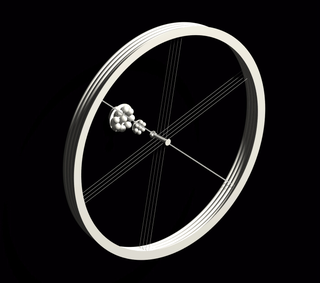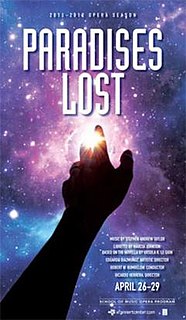
Ursula Kroeber Le Guin was an American author best known for her works of speculative fiction, including science fiction works set in her Hainish universe, and the Earthsea fantasy series. She was first published in 1959, and her literary career spanned nearly sixty years, producing more than twenty novels and over a hundred short stories, in addition to poetry, literary criticism, translations, and children's books. Frequently described as an author of science fiction, Le Guin has also been called a "major voice in American Letters". Le Guin said she would prefer to be known as an "American novelist".

The Dispossessed is a 1974 anarchist utopian science fiction novel by American writer Ursula K. Le Guin, one of her seven Hainish Cycle novels. It is one of a small number of books to win the Hugo, Locus and Nebulas Awards for Best Novel. It achieved a degree of literary recognition unusual for science fiction due to its exploration of themes such as anarchism and revolutionary societies, capitalism, utopia, and individualism and collectivism.
The Hainish Cycle consists of a number of science fiction novels and stories by Ursula K. Le Guin. It is set in a future history in which civilizations of human beings on planets orbiting a number of nearby stars, including Terra ("Earth"), are contacting each other for the first time and establishing diplomatic relations, setting up a confederacy under the guidance of the oldest of the human worlds, peaceful Hain. In this history, human beings did not evolve on Earth but were the result of interstellar colonies planted by Hain long ago, which was followed by a long period when interstellar travel ceased. Some of the races have new genetic traits, a result of ancient Hainish experiments in genetic engineering, including people who can dream while awake, and a world of androgynous people who only come into active sexuality once a month, not knowing which sex will manifest in them. In keeping with Le Guin's style, she uses varied social and environmental settings to explore the anthropological and sociological outcomes of human evolution in those diverse environments.

Orphans of the Sky is a science fiction novel by American writer Robert A. Heinlein, consisting of two parts: "Universe" and its sequel, "Common Sense". The two novellas were first published together in book form in 1963. "Universe" was also published separately in 1951 as a 10¢ Dell paperback. The work presents one of the earliest fictional depictions of a generation ship.

A generation ship, or generation starship, is a hypothetical type of interstellar ark starship that travels at sub-light speed. Since such a ship might require hundreds to thousands of years to reach nearby stars, the original occupants of a generation ship would grow old and die, leaving their descendants to continue traveling.

Rocannon's World is a science fiction novel by American writer Ursula K. Le Guin, her literary debut. It was published in 1966 as an Ace Double, along with Avram Davidson's The Kar-Chee Reign, following the tête-bêche format. Though it is one of Le Guin's many works set in the universe of the technological Hainish Cycle, the story itself has many elements of heroic fantasy. The hero Gaveral Rocannon encounters lords who live in castles and wield swords, and other races much like fairies and gnomes, in his travels on a backward planet.

City of Illusions is a 1967 science fiction novel by American writer Ursula K. Le Guin. It is set on Earth in the distant future, and is part of her Hainish Cycle. City of Illusions lays the foundation for the Hainish cycle which is a fictional universe in which the majority of Ursula K. Le Guin's science fiction novels take place.

Ammonite is British-American author Nicola Griffith's debut novel, which was published in 1992. Styled as a meditation on queer ideologies, the novel explores themes of sexuality, gender, illusion, and humanity, as well as virology. While setting aside numerous dogmatic feminist tropes, Griffith fully tackles the conundrum of whether a world run by women would be a gentler or better one. American author Ursula Le Guin cited Ammonite as “a knock-out first novel, with strong, likeable characters, a compelling story, and a very interesting take on gender.

The Word for World Is Forest is a science fiction novella by American writer Ursula K. Le Guin, first published in the United States in 1972 as a part of the anthology Again, Dangerous Visions, and published as a separate book in 1976 by Berkley Books. It is part of Le Guin's Hainish Cycle.
Toby Litt is an English writer and academic in the Department of English and Humanities at Birkbeck, University of London.

Non-Stop is a 1958 science fiction novel by British writer Brian Aldiss. It is about problems that the inhabitants of a huge generation space ship face after an alien amino acid that they picked up on another planet triggers a pandemic. Law and order began to collapse, and knowledge of the ship and its purpose was eventually almost entirely lost throughout the vessel.

The Eye of the Heron is a 1978 science fiction novel by American author Ursula K. Le Guin which was first published in the science fiction anthology Millennial Women.

Journey to the Seventh Planet is a 1962 Danish-American science fiction film. It was directed by Sid Pink, written by Pink and Ib Melchior, and shot in Denmark with a budget of only US$75,000.

"The Shobies' Story" is a 1990 science fiction novella by American writer Ursula K. Le Guin, describing the story of the first human crew to participate in a newly invented faster-than-light mode of space travel. It was first published in the anthology Universe 1 and subsequently appeared in A Fisherman of the Inland Sea published by Harper Prism in 1994.

The Left Hand of Darkness is a science fiction novel by U.S. writer Ursula K. Le Guin. Published in 1969, it became immensely popular, and established Le Guin's status as a major author of science fiction. The novel is set in the fictional Hainish universe as part of the Hainish Cycle, a series of novels and short stories by Le Guin, which she introduced in the 1964 short story "The Dowry of Angyar". It was fourth in sequence of writing among the Hainish novels, preceded by City of Illusions, and followed by The Word for World Is Forest.

The Great Lover is a 2009 biographical novel by Jill Dawson. The novel follows the fictional Nell Golightly as she encounters the eccentric poet Rupert Brooke in Grantchester, Cambridgeshire. Set from 1909 until 1914, in the novel Dawson examines Brooke's relationship with Nell, and his growth as a poet and individual. The novel is based on the biography of Brooke during that period, incorporating opinions, ideas, and excerpts from Brooke's letters and other primary sources documenting his life.
"Vaster than Empires and More Slow" is a science fiction story by American author Ursula K. Le Guin, first published in the collection New Dimensions 1, edited by Robert Silverberg. It is set in the fictional Hainish universe, where Earth is a member of an interstellar "League of Worlds". The anthology was released in United States in 1971, by Doubleday Books.
"The Dowry of Angyar" is a science fiction short story by American writer Ursula K. Le Guin, first published in 1964. It is the first work of the Hainish Cycle. The story is set on a fictional planet of the star Fomalhaut, and follows a highborn woman as she tries to track down a family heirloom. It was framed by commentary from ethnologists studying the intelligent life-forms of the Fomalhaut system. The story drew from Norse mythology, and explored the concept of time dilation. "The Dowry of Angyar" drew comments for its stylistic devices, while a review praised Le Guin's writing as "crystalline prose". It was later used as the prologue to Le Guin's 1966 novel Rocannon's World. In later publications, the story was given the title "Semley's Necklace".

Paradises Lost is a science fiction novella by American author Ursula K. Le Guin. It was first published in 2002 as a part of the collection The Birthday of the World. It is set during a multigenerational voyage from Earth to a potentially habitable planet. The protagonists, Liu Hsing and Nova Luis, are members of the fifth generation born on the ship. The story follows them as they deal with members of religious cult who do not believe in the ship stopping at its intended destination. They also face a crisis brought on by a drastic change in the ship's schedule. The novella has since been anthologized as well as adapted into an opera of the same name.















